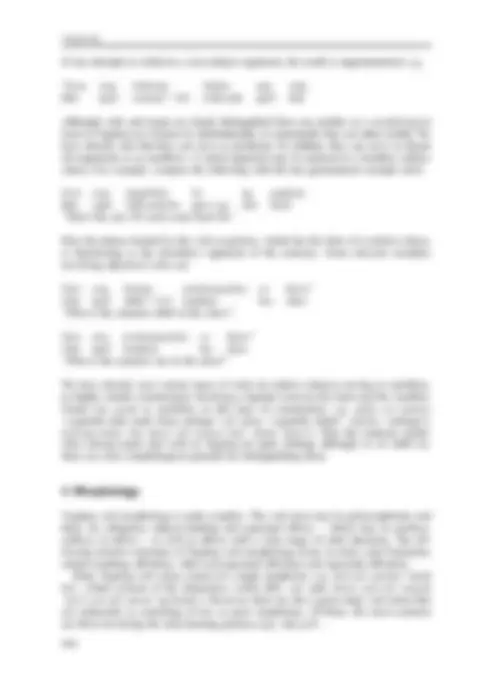

















Study with the several resources on Docsity

Earn points by helping other students or get them with a premium plan


Prepare for your exams
Study with the several resources on Docsity

Earn points to download
Earn points by helping other students or get them with a premium plan
Community
Ask the community for help and clear up your study doubts
Discover the best universities in your country according to Docsity users
Free resources
Download our free guides on studying techniques, anxiety management strategies, and thesis advice from Docsity tutors
An overview of Tagalog verb morphology, focusing on stem formation, subject-marking affixation, other non-aspectual affixation, and aspectual affixation. It also discusses the syntactic similarities between nouns and verbs in Tagalog and the various types of affixes used in Tagalog verbs.
What you will learn
Typology: Assignments
1 / 23

This page cannot be seen from the preview
Don't miss anything!
















Tagalog is a member of the Central Philippine subgroup of Philippine languages, forming part of the Western-Malayo-Polynesian set of Austronesian languages. It belongs in a subgroup with Bikol, Bisayan and Mansakan languages and was originally probably native to the eastern Visayas or northeast Mindanao in the Central Philippines (Zorc 1993). By the time the Spanish arrived in the Philippines (1521), Tagalog speakers had migrated north into the southern part of the island of Luzon in the Philippines, with Tagalog becoming the major language spoken in Manila and surrounding provinces; it has in recent years spread as a second language over virtually the entire Philippine archipelago. Thus, while only about a quarter of the population of the Philippines were Tagalog-speaking in 1940, in 1970 approximately half of the population were, and today it is estimated that well over 90 per cent of the 80 million total population of the Philippines is either a first- or second-language speaker of the language. Tagalog was selected in 1937 as the national language of the Philippines, and was established as such in the 1987 Constitution of the country. Under the name of Filipino, Tagalog is now taught in schools throughout the Philippines. The spread of the lan- guage has also been favoured by urbanisation – Tagalog is native to the largest city of the Philippines, Manila, and it is used as a lingua franca in many cities with mixed populations – as well as by its prominence in the mass media. The dialect of Tagalog which is considered standard and which underlies Filipino is the educated dialect of Manila. Other important regional dialects are those of Bataan, Batangas, Bulacan, Tanay-Paete and Tayabas. The lexicon of educated Manila Tagalog contains many borrowings from Spanish and English, the former reflecting over three centuries of colonial domination of the Philippines by Spain, the latter reflecting the period of American hegemony (1898–1946), as well as the current status of English as one of the languages (along with Filipino) of higher education in the Philippines and a lingua franca second in importance only to Filipino itself. Spanish and English have
also had some impact on the phonology of Tagalog (see Section 2, below), but little if any on the syntax and morphology. (See Section 4, however, for some instances of borrowed Spanish gender distinctions.)
Tagalog phonology has been significantly affected by the incorporation into the lan- guage of many loanwords from Spanish, English and other languages. One effect of this incorporation has been an expansion of the phonemic inventory of the language, an expansion that has influenced both the vowel and the consonant systems. Contemporary Tagalog has the five vowel phonemes shown in Table 49.1.
This five-vowel system no doubt developed out of a three-vowel system in which [i] and [e] were allophones of a single phoneme and [u] and [o] were allophones of another. Contrasts between /i/ and /e/ and between /u/ and /o/ are, however, well established in contemporary Tagalog, not only in borrowed vocabulary (misa /mi:sa/ ‘mass’ vs mesa /me:sa/ ‘table’, bus /bu:s/ ‘bus’ vs bos /bo:s/ ‘boss’) but, albeit less commonly, in native vocabulary as well (iwan /?i:wan/ ‘leave’ vs aywan /?e:wan/ ‘not known’, babuy /ba:buy/ ‘pig-like person’ vs baboy /ba:boy/ ‘pig’). Vowel length in non-word-final syllables is phonemic, as the following examples illustrate: aso /?a:so/ ‘dog’, aso /?aso/ ‘smoke’, maglalakbay /magla:lakbay/ ‘will travel’, maglalakbay /maglalakbay/ ‘travel a lot’. In word-final syllables of native words, vowel length is not phonemic: the general rule is that phrase-final syllables are long, non-phrase-final syl- lables short. Thus sibat /sibat/ ‘spear’ is pronounced [siba:t] phrase-finally, but not in sibat ba? /sibat ba/ [sibat ba:] ‘is it a spear?’ Word-final syllables of non-native words may, however, show phonemic length. For example, borrowed monosyllabic names have a long vowel in any context: e.g. Si Bob ba? /si ba:b ba/ [si ba:b ba:] ‘Is it Bob?’ There are sixteen consonant phonemes that occur in native words. These are dis- played in Table 49.2. Probably [d] and [r] were once allophones of a single phoneme, as is evidenced by a good deal of free or morphophonemically conditioned alternation between them (e.g. daw /daw/ ~ raw /raw/ ‘they say’, dalita /da:lita?/ ‘poverty’ vs maralita /mara:lita?/ ‘poor’). There is no doubt, however, that they now contrast, not only in loanwords (dos /do:s/ ‘two’ vs Rose /ro:s/ ‘Rose’) but in native words as well (maramdamin /maramda:min/ ‘sensitive’ vs madamdamin /madamda:min/ ‘moving’). In addition to the consonant phonemes found in native Tagalog words, shown in Table 49.2, there are several others that only occur in loanwords but are commonly heard in the speech of many Tagalog speakers, especially those with higher education in English. These include the labio-dental fricatives /f/ and /v/ and the alveolar affricates
Table 49.1 Tagalog Vowel Phonemes
Front Central Back
High i u Mid e o Low a
sentence types (e.g. requests for information vs requests for repetition), to express speaker attitudes (e.g. cordiality), to indicate contrast or emphasis, etc. Prior to the Spanish colonisation of the Philippines, a syllabary, probably ultimately of Indian origin, had been used for writing Tagalog, but under the Spanish this was sup- planted by a version of the Roman alphabet. Nowadays Tagalog uses the same 26 letters that are used for writing English, although the seven letters c, f, j, q, v, x and z are used chiefly in proper names of foreign origin and in certain other borrowings from English or Spanish. These seven letters are not included in the conventional Tagalog alphabet, or abakada, which consists of 20 letters (including the digraph ng, used for /ŋ/), in the following order: a b k d e g h i l m n ng o p r s t u w y. The writing system does not indicate vowel length (or stress), and does not mark /?/ except as a hyphen between consonant final prefixes and words that begin with a glottal stop that would otherwise be written as vowel-initial, for example mag-iigi /mag?i:?i:gi/ ‘to adjust’. Thus words that differ from one another only in vowel length (see examples above) or only in that one ends in a vowel and the other in /?/ (e.g. bata /ba:ta/ ‘bathrobe’ and bata /ba:ta?/ ‘child’) are spelled identically. There is also some inconsistency – as well as some debate – with regard to the spelling of loanwords, e.g. molecule vs molikyul. And there are two very common words, the case-marking form /naŋ/ and the plural form /maŋa/, whose conventional spellings, respectively ng and mga, are non-phonemic. With these and a few other exceptions, however, there is a fairly good match between spelling and pronunciation.
The syntax of Tagalog and other Philippine languages has been the subject of an on- going debate among syntacticians in recent years, as a clearer understanding of the nature of the relationships between the different constructions in the language have become clearer, and the goals of linguistic theory and description have changed. The first grammars by Spanish linguists and missionaries in the sixteenth and seventeenth centuries described the language in traditional Latin grammar terminology, but following the structuralist ana- lyses of Bloomfield in the early part of the twentieth century, a model was established that typically described the language as containing a ‘focus’ system thought to be unique among the world’s languages, in which the semantic role of one of the argu- ments, actor, experiencer, goal, instrument, location, beneficiary, etc., could be marked with an affix on the verb, thus ‘focusing’ that participant and creating a paradigm of structural types, one of which was active (or ‘actor focus’) and the others passive (goal passive or ‘object focus’, instrument passive or ‘instrument focus’, and so on). The ‘focused’ argument has been variously labelled as topic, subject, trigger and pivot. Various problems with the ‘focus’ model, including the fact that the so-called ‘pas- sive’ constructions do not function as typical passives, but are the unmarked way to express any structure containing a definite patient, have resulted in a number of differ- ent approaches that are more consistent with modern linguistic theory. These approa- ches fall into two main categories, those that consider Tagalog (or some other Philippine language) to be an ergative or a split-ergative language, and those that con- sider it to have either an ‘active’, ‘fluid’, ‘hybrid’ or ‘symmetrical’ voice system. To date, the ergative analysis is the most common among studies written in a wide range of theoretical frameworks, including Relational Grammar, Role and Reference Grammar,
Categorial Grammar, Lexicase, Localist frameworks, Dixon’s Basic Linguistic Theory, Government and Binding, and Minimalist frameworks, as well as general typological approaches, and will be the approach followed in the following description. Tagalog is a predicate-initial language. That is, in the most common and basic type of clause, words or phrases that express predicates precede words or phrases that express arguments. Predicates belong to one of two classes: verbal and non-verbal. The structures of basic clauses containing these two types of predicates are discussed in turn below. Clauses with verbal predicates consist of a verb followed by one or more arguments (noun phrases, pronouns, etc.). These arguments do not in general occur in a fixed order, although the ‘focused noun phrase’, referred to hereafter as the grammatical subject (or absolutive noun phrase), commonly occurs last, and word order is not used in distin- guishing the roles that are assigned to the various arguments, e.g. in distinguishing an actor argument (see below) from a patient argument. Instead these roles are indicated by the form of the verb and/or the form of the argument expressions themselves. The verb typically contains an affix – which may be a prefix, an infix or a suffix – that indicates the semantic role of the grammatical subject. This phrase has the same form, whatever the semantic role of its referent. The semantic roles of any other arguments in the clause, however, are indicated by the forms of the noun phrases themselves: for example, an argument that expresses the actor of a transitive clause (that is, the ergative noun phrase) is introduced by ng /naŋ/ if it is a common noun, or by ni if it is a personal name. As an ergative language, the case-marking of the actor or experiencer of an intran- sitive sentence (indicated in Examples 1a–b as S) is identical to that of the most patient-like argument of a transitive sentence (indicated in Examples 2a–d as P). In these sentences the specifiers of the S and the P phrases are shown in bold font. The agent of a transitive sentence (indicated as A) carries ergative case-marking. Examples 2b–d are also transitive sentences, having the same structural features as 2a, except that the semantic role of the absolutive is different, location in 2b, beneficiary in 2c, and instrument in 2d, each marked by a different form of the transitive verb. Of each of the square-bracketed noun phrases in the examples, only those marked as S, A and P are core noun phrases, implied by the verbal semantics, others phrases are adjuncts and optional. (All of the verbs in these examples contain a reduplicating imperfective aspect prefix CV:-, thus aalis /?a:?alis/; other affixes, shown in bold font, either mark the semantic role of the absolutive phrase, or carry other aspectual meanings whose functions will be explained in Section 4).
1 Intransitive a Aalis [ang tindero] (^) abs. [sa Lunes.] (^) loc. will.leave S storekeeper Monday ‘The storekeeper will leave on Monday.’
b Magluluto [ang tindero] (^) abs. [para sa babae.] (^) ben. will.cook S storekeeper woman ‘The storekeeper will cook for the woman.’
2 Transitive a Aalisin [ng tindero] (^) erg. [ang bigas] (^) abs. [sa sako.] (^) loc. will.take.out A storekeeper P rice sack ‘A/The storekeeper will take the rice out of the sack.’
in which the oblique phrase is labelled E for ‘extended’, following the Dixon–Aikhenvald terms used in their Basic Linguistic Theory. Like the oblique adjuncts marked by ng in transitive sentences, this phrase is obligatorily indefinite and cannot be substituted with a personal noun or pronoun. This structure has been variously labelled as pseudo- transitive, or as anti-passive, and its analysis is the source of much controversy in the lit- erature. For linguists who consider the semantic transitivity of this structure as primary, the phrase marked here as oblique is analysed as accusative, making Tagalog a split- ergative language. For linguists who consider that the forms of the verbal prefixes in these structures, matching as they do the affixation on monadic intransitive verbs (compare 3a with 1a, and 3b with 1b), but not the affixation of unambiguously transitive con- structions, the structures are syntactically intransitive. Some contend that since this phrase is a core argument, Tagalog should be considered to have a symmetrical voice system.
3 Dyadic intransitive a Gagawa [ng kubo] (^) obl. [ang tindero.] (^) abs. will.make E hut S storekeeper ‘The storekeeper will make a hut.’
b Mag-aalis [ng bigas] (^) obl. [ang tindero.] (^) abs. will.take.out E rice S storekeeper ‘The storekeeper will take out some rice.’
The distinction between each of the structures illustrated above has often been characterised as ‘voice’ so that Examples 3a–b are ‘actor voice’, 2a ‘patient voice’, 2b ‘locative voice’, 2c ‘beneficiary voice’ and 2d ‘instrumental’ or ‘conveyance voice’. The four transitive voice types have also been labelled as ‘undergoer voice’, because of their structural similarities. Some linguists have also argued that the so-called locative, beneficiary and instrumental voices are derived applicative constructions. As noted previously, the order of post-verbal arguments is generally free. Thus in addi- tion to the orderings shown above, any other ordering of the arguments in the examples would also be grammatical (although some would be unusual). There is, however, a gen- eral preference for the actor as the first argument in a transitive clause and for either the actor or the oblique patient as the first argument in an extended intransitive clause. There is also one set of nominal expressions whose order in relation to other nominal expressions and to one another is not free. These are the absolutive and ergative per- sonal pronouns, which are enclitics: i.e. they occur in a fixed position immediately after the clause-initial constituent. If there are two enclitic pronouns in the same clause, they observe the rule that monosyllabic pronouns precede disyllabic pronouns. Thus in the following sentence the order of all the words is fixed:
Nakita mo siya kahapon. saw erg.2.sg. abs.3.sg. yesterday ‘You saw him yesterday.’
This contrasts with the variable ordering observable in the following sentences, which show that argument expressions are freely ordered in relation not only to one another but also to adverbs such as kahapon ‘yesterday’:
Nakita ni Juan si Maria kahapon. saw erg. Juan abs. Maria yesterday Nakita ni Juan kahapon si Maria. Nakita si Maria ni Juan kahapon. Nakita si Maria kahapon ni Juan. Nakita kahapon ni Juan si Maria. Nakita kahapon si Maria ni Juan. ‘Juan saw Maria yesterday.’
In addition to enclitic pronouns, Tagalog also has a set of enclitic adverbial particles that occur in a fixed position in relation to other sentence elements. Note, for example, the position of the interrogative ba in the following sentence:
Nakita mo ba siya kahapon? saw erg.2.sg. Q abs.3.sg. yesterday ‘Did you see him yesterday?’
Clauses with non-verbal predicates are in many cases translated into English by sentences with the main verb be, which has no Tagalog counterpart. These clauses consist of a pre- dicate expression followed by an absolutive noun phrase. The predicate expression may be a noun, an adjective or a prepositional phrase. Some examples are:
Abogado ang bunso. be.lawyer spcf. youngest.child ‘The youngest child is a lawyer.’
Hinog ang mga mangga. be.ripe spcf. pl. mango ‘The mangos are ripe’
Nasa kusina si Nene. be.in kitchen spcf.pers. Nene ‘Nene is in the kitchen.’
A construction consisting of a non-verbal phrasal predicate having an existential word immediately followed by an unmarked noun and an absolutive phrase is also used to express possession, as in:
[May trak] (^) prd. si Ben. exist truck spcf.pers. Ben ‘Ben has a truck.’
The same type of non-verbal predicate is also used to express existence. In this case, however, the predicate is not followed by an absolutive phrase, but is instead typically followed by a locative adverb, e.g.
[May trak] (^) prd. doon. EXIST truck there ‘There’s a truck over there.’
demonstrative ito ‘this’ precedes the ligature, the /ŋ/ form occurs and when the noun galang /galaŋ/ ‘bracelet’ precedes, the /na/ form occurs: thus itong galang /itoŋ galaŋ/, galang na ito /galaŋ na itoh/ ‘this bracelet’. Similarly, the noun bata /ba:ta?/ ‘child’ and the adjective gutom /gutom/ ‘hungry’ respectively require the /ŋ/ and /na/ forms of the ligature in batang gutom /ba:taŋ gutom/ ‘hungry child’ and gutom na bata /gutom na ba:ta?/. Although a demonstrative and the noun it modifies may occur in either order, the alternative orderings are generally not in free variation, but are, rather, conditioned by discourse factors. The constituent that comes second typically represents the more salient information and may, for example, be contrastive. Thus:
Mahal itong galang. (Pero mura itong singsing.) be.expensive this = LG bracelet but cheap this = LG ring ‘This bracelet is expensive. (But this ring is cheap.)’
Mahal ang galang na ito. (Pero mura ang galang na iyan.) be.expensive spcf. bracelet LG this but cheap spcf. bracelet LG that ‘This bracelet is expensive. (But that bracelet is cheap.)’
(As the first example illustrates, when the grammatical subject begins with a demon- strative, no specifying form is used.) The alternative orderings of adjectival verbs and the nouns they modify, on the other hand, often do appear to be a matter of free var- iation. Some analysts, however, contend that the initial form in such constructions is the syntactic head, and the form that follows the ligature is a relative clause with a pre- dicate nominal as its head, i.e. ‘this one which is a bracelet’ vs ‘the bracelet which is this one’; see the discussion on relative clauses below. Possessive pronouns, as noted, may also either precede or follow the noun, but in this case a difference in form is associated with the difference in order. When the pos- sessive pronoun precedes, it takes the locative form and is obligatorily linked to the following noun by a ligature. When the possessive pronoun follows, it takes a form that has been called the genitive form and there is no ligature. For example, ‘my house’ may be expressed as either aking bahay (the locative first person singular pronoun akin
Kailan mo (ba) siya nakita? when gen.2.sg. Q abs.3.sg. saw ‘When did you see him?’
Sa aling parti ka (ba) pumunta? loc. which = LG party abs.2.sg. Q went ‘Which party did you go to?’
If the questioned constituent is an absolutive noun phrase, a wh-cleft construction is used, the question word itself forming the predicate, and the rest of the clause expres- sed as an absolutive construction introduced by one of the specifiers that introduce such phrases, such as ang. Some examples are:
Ano (ba) ang ginawa mo kahapon? what Q spcf. did gen.2.sg yesterday ‘What did you do yesterday?’ Lit. ‘What is it that you did yesterday?’
Sino (ba) ang gumawa ng sapatos na iyon? who Q spcf. made obl. shoes LG that ‘Who made those shoes?’ Lit. ‘Who is it that made those shoes?’
If the questioned constituent is a genitive noun phrase, a wh-in situ construction is used, a genitively marked question word appearing in the body of the clause, following the predicate, such as:
Ninakaw nino ang kotse mo? stole (^) gen. who spcf. car gen.2.sg ‘Who stole your car?’ (Kroeger 1993: 212)
Imperative sentences of the most common type have a falling intonation pattern like that of question-word questions. Syntactically they are just like statements with verbal predicates and second-person actors (which are either absolutive, if the patient is inde- finite, or genitive, if the patient is definite), except that the verb is in the infinitive form, rather than one of the finite forms that are found in statements. Some examples are:
Mag-alis ka ng bigas sa sako! take.out abs.2.sg. obl. rice loc. sack ‘Take some rice out of a/the sack.’
Basahin mo nga ang librong ito! read-pt. gen.2.sg please spcf. book = LG this ‘Please read this book.’
(Nga ‘please’ in the last example is an enclitic adverbial particle.) Hortative sentences are identical to imperatives, except that the actor is a first person plural inclusive pronoun (see Section 4). For example:
always represents the addressee of an imperative sentence. It is also the actor that controls the reference of a reflexive (expressed by a possessive pronoun and the nominal sarili ‘self’), as illustrated by the following sentences:
Mag-aalaala ang lolo sa kaniyang sarili. worry.about spcf. grandfather loc poss. = LG self ‘Grandfather will worry about himself.’
Aalalahanin ng lolo ang kaniyang sarili. worry.about gen. grandfather spcf. poss. = LG self ‘Grandfather will worry about himself.’
Since the first of these sentences has an intransitive verb, the actor, which is the reflexive controller, happens to be the grammatical subject as well. The second sentence, however, has a transitive verb and here we can see clearly that the reflexive controller is the actor and not the grammatical subject, since in this case it is the subject itself that is reflexivised. On the other hand, there are certain subject-like properties that are associated with the absolutive noun phrase. One such property is relativisability. Only absolutive argu- ments (and certain constituents of such arguments) may be relativised in Tagalog. Thus if one wishes to relativise an actor, an intransitive clause must be used; if one wishes to relativise a patient, a transitive clause must be used; etc. The following examples illustrate this. (As the examples show, relativisation in Tagalog involves the deletion of the relativised argument from the relative clause. The head of the relative clause and the clause itself may occur in either order, but head-first is the more common ordering. A ligature occurs between the head and the relative clause.)
Iyon ang babaeng magluluto ng isda. that spcf. woman = LG will.cook obl. fish ‘That’s the woman who will cook some fish.’
Iyon ang isdang iluluto ng babae. that spcf. fish = LG will.cook gen. woman ‘That’s the fish that a/the woman will cook.’
In the first sentence the actor is relativised, so the verb in the relative clause must be intransitive; in the second sentence the patient is relativised, so the verb in the relative clause must be transitive. Similarly, if a locative argument is relativised, the verb in the relative clause must be derived as a locative-effect verb, and if a benefactive argument is relativised, the verb in the relative clause must be derived as a beneficiary-effect verb, as in:
Iyon ang sakong aalisan ko ng bigas. that spcf. sack = LG will.take.out.from gen.1.sg. obl. rice ‘That’s the sack that I’ll take some rice out of.’
Iyon ang batang ipagluluto ko ng pagkain. that spcf. child = LG will.cook.for gen.1.sg. obl. food ‘That’s the child I’ll cook some food for.’
If one attempts to relativise a non-subject argument, the result is ungrammatical, e.g.
*Iyon ang babaeng iluluto ang isda. that spcf. woman = LG will.cook spcf. fish
Although verbs and nouns are clearly distinguished from one another on a morphological basis in Tagalog (see Section 4), distributionally or syntactically they are rather similar. We have already seen that they can serve as predicates. In addition, they can serve as (heads of) arguments or as modifiers. A verbal argument may be analysed as a headless relative clause. For example, compare the following with the last grammatical example cited:
Iyon ang ipagluluto ko ng pagkain. that spcf. will.cook.for gen.1.sg. obl. food ‘That’s the one I’ll cook some food for.’
Here the phrase headed by the verb ipagluluto, which has the form of a relative clause, is functioning as the absolutive argument of the sentence. Some relevant examples involving adjectival verbs are:
Sino ang batang pinakamatalino sa klase? who spcf. child = LG smartest loc. class ‘Who is the smartest child in the class?’
Sino ang pinakamatalino sa klase? who spcf. smartest loc. class ‘Who is the smartest one in the class?’
We have already seen various types of verbs (in relative clauses) serving as modifiers, in highly similar constructions involving a ligature between the head and the modifier. Nouns too occur as modifiers in this type of construction: e.g. gulay na repolyo ‘vegetable dish made from cabbage’ (cf. gulay ‘vegetable (dish)’, repolyo ‘cabbage’), laruang kalan ‘toy stove’ (cf. laruan ‘toy’, kalan ‘stove’). Thus the syntactic simila- rities among nouns and verbs in Tagalog are quite striking, although, as we shall see, there are clear morphological grounds for distinguishing them.
Tagalog verb morphology is quite complex. The verb stem may be polymorphemic and there are obligatory subject-marking and aspectual affixes – which may be prefixes, suffixes or infixes – as well as affixes with a wide range of other functions. The fol- lowing selective summary of Tagalog verb morphology treats, in order: stem formation, subject-marking affixation, other non-aspectual affixation and aspectual affixation. Many Tagalog verb stems consist of a single morpheme: e.g. abot (cf. umabot ‘reach for’, which consists of the intransitive verbal affix -um- plus abot), iyak (cf. umiyak ‘cry’), uwi (cf. umuwi ‘go home’). However, there are also a great many verb stems that are analysable as consisting of two or more morphemes. Of these, the most common are those involving the stem-forming prefixes pag- and paN-.
reduplicating prefix is to form the stem of ‘moderative’ verbs, i.e. verbs that designate activities performed in moderation, occasionally, at random, etc. Some examples are hiya-hiya, the stem of intransitive mahiya-hiya ‘be a little ashamed’ (cf. mahiya ‘be ashamed’) and linis-linis, the stem of transitive linis-linisin ‘clean s.t. a little’ (cf. linisin ‘clean s.t.’). As indicated above, the subject-marking affixes are said to mark the semantic role of the absolutive phrase. Among the roles that may be affixally marked are: actor, patient, location, beneficiary and instrument. (Others, which will not be discussed here, include location, reason and referent (‘about’ object).) The affixes that most commonly mark these roles are shown in Table 49.3. The affixes that signal that the absolutive noun phrase expresses an actor form verbs that are either monadic or dyadic intransitives. The other affixes typically occur in canoni- cal transitive constructions, although they may also occur in a small number of clearly intransitive constructions in which the subject is experiencer of an ‘afflicted’ or ‘adversely affected’ state, e.g. antukin ‘feel sleepy’(cf. antok ‘drowsiness’), lamukin ‘be infested with mosquitos’ (cf. lamok ‘mosquito’), langgamin ‘be infested with ants’ (cf. langgam ‘ant’), kilabutan ‘feel terrified’ (cf. kilabot ‘goose pimples’), pawisan ‘sweat’, etc. These also include physical conditions derived from the following nouns: sipon ‘cold’, lagnat ‘fever’ and malat ‘hoarseness’, as well as natural phenomena, such as ulan ‘rain’, bagyo ‘storm’, lindol ‘earthquake’, etc. (De Guzman 1978). The forms of the affixes given in the table are those that occur in infinitives. Some subject-marking affixes assume different forms in certain finite (i.e. aspect marked) verbs. These forms will be presented later, in connection with the discussion of aspectual affixation. As Table 49.3 shows, there are several different affixes that signal actor, patient and location subjects. The choice among these affixes is lexically determined and to some extent idiosyncratic, although there are certain generalisations that can be made. The intransitive affixes, all of which mark that the actor is subject and all of which involve the phoneme /m/, are the infix -um- and the prefixes m-, ma- and maka-. -um- is infixed between the first consonant and first vowel of the stem, e.g. humingi ‘borrow’ (stem: hingi), sumulat ‘write’ (stem: sulat), tumakbo ‘run’ (stem: takbo). (In the written form of verbs whose stem-initial consonant is /?/, -um- appears as a prefix, since /?/ is not represented in the standard orthography: e.g. umabot /?umabot/ ‘reach for’ (stem:
verbs having single-morpheme stems and its occurrence in certain subclasses of verbs is predictable, e.g. in verbs of ‘becoming’ where the stem also occurs as the stem of a ma- adjectival verb, cf. gumanda ‘become beautiful’, maganda ‘be beautiful’, tumaas ‘become tall’, mataas ‘be tall’. The prefix m- replaces the initial p- of the stem-forming prefixes pag- and paN-, resulting in the forms mag- and maN- respectively, as in magbigay ‘give’, magluto ‘cook’,
Table 49.3 Affixes
Actor -um-, m-, ma-, maka- Patient -in, i-, -an, ma- Location -an, -in Beneficiary, Instrument i-
mangisda ‘fish’ (cf. isda ‘fish (noun)’), mangailangan ‘need’ (cf. kailangan ‘need (noun)’). As indicated above, mag- occurs productively in verbs that express a characteristic activity involving the referent of the noun that underlies them (e.g. mag-Ingles ‘speak English’). There are also certain regular correspondences between -um- and mag- verbs formed with the same stem, e.g. cases in which the -um- verb takes two arguments and the mag- verb three, such as: pumasok ‘come/go into’ and magpasok ‘bring/take into’, lumabas ‘come/go outside’ and maglabas ‘bring/take outside’. MaN- too has certain char- acteristic uses – for example in verbs indicating destructive activity, such as mangwalis ‘hit with a broom’ (cf. magwalis ‘sweep’) – but it is considerably less common than mag-. Intransitive ma- (there is also a transitive ma-) occurs productively in verbs of ‘becom- ing’ whose stems are unaffixed adjectival verbs – e.g. mabingi ‘become deaf’ (cf. bingi ‘be deaf’), mamahal ‘become expensive’ (cf. mahal ‘be expensive’) – and idiosyncratically in a relatively small number of other common verbs, e.g. matulog ‘sleep’, matuto ‘learn’. Maka- occurs idiosyncratically in a few common verbs, e.g. makakita ‘see’, makarinig ‘hear’. (Maka- also occurs productively in abilitative verbs – see below.) The most common affixes marking simple transitive verbs are -in and i-. -in is the most frequent transitive counterpart of intransitive -um- verbs in corresponding sets formed with the same stem (e.g. intransitive humuli ‘catch’/ transitive hulihin ‘catch s.t.’) and i- is the most frequent counterpart of intransitive m- verbs, (though there are also a good many intransitive m-/transitive -in correspondences, including some cases where -in and i- are apparently in free variation, e.g. intransitive magluto ‘cook’/transitive iluto ~ lutuin ‘cook s.t.’). The stem-forming prefix pag- that occurs in intransitive m- verbs is often obligatorily absent – less often optionally absent – from the correspond- ing simple transitive verbs. (This is also true of locative-effect verbs formed with -in, and of both simple transitive and locative-effect transitive verbs formed with -an – see below.) For example, the transitive counterpart of intransitive magbigay ‘give’ is ibigay ‘give s.t.’ and the transitive counterpart of intransitive magkaila ‘deny’ is either ikaila or ipagkaila. (On the other hand, the transitive counterpart of intransitive magbili ‘sell’ is ipagbili, in which pag- is obligatorily retained.) Much less commonly, a stem- forming prefix paN- that occurs in an intransitive verb is omitted from the transitive counterpart, e.g. the patient-transitive counterpart of intransitive mangailangan ‘need’ is kailanganin. The suffix -an, which is the most common locative-effect affix, occurs less frequently as a simple transitive affix, often in verbs that express actions involving surface contact with, or surface effect on, the patient, e.g. labhan ‘launder s.t.’, pintahan ‘paint s.t.’, walisan ‘sweep s.t.’, hawakan ‘hold s.t.’. Ma- is the transitive counterpart of intransitive maka- and occurs idiosyncratically in a few verbs: e.g. makita ‘see s.t.’, marinig ‘hear s.t.’. Some examples of locative-effect verbs with -an are: puntahan ‘go to some place’, up(u)an ‘sit on s.t.’, masdan ‘look at s.t.’, bilhan ‘buy from some place’ (also func- tioning as a beneficiary-effect verb with the meaning ‘buy for someone’). The suffix -in occurs idiosyncratically as a locative-effect affix in a few verbs – e.g. pupuin ‘use po (sir/madam) in addressing someone’ – and more systematically in certain other cases, among them cases in which locative-effect -an is, as it were, pre-empted. These are cases in which -an is used as the locative-effect affix of a three argument verb and -in as the locative-effect affix of a two-argument verb formed with the same stem: e.g. pasukan ‘bring/take into some place’ vs pasukin ‘come/go into some place’, labasan ‘bring/take to some place outside’ vs labasin ‘come/go to some place outside’.
actual, or realis and events viewed as hypothetical, or irrealis. Among the actual events, there is a distinction between those viewed as complete and those viewed as incomplete. Events viewed as complete are in the perfective aspect, those viewed as incomplete are in the imperfective aspect and those viewed as hypothetical are in the contemplated aspect. The perfective aspect is often translated into English by the past or the present perfect, the imperfective aspect by the simple present or by the present or past pro- gressive and the contemplated aspect by the future, e.g. perf. nagwalis ‘swept, has swept’, imperf. nagwawalis ‘sweeps, is/was sweeping’, cont. magwawalis ‘will sweep’. There are, however, other translation equivalents in certain cases. For example, the imperfective rather than the perfective form is used for the equivalent of the English negative perfect. Thus ‘hasn’t swept yet’ is expressed by hindi pa nagwawalis, not *hindi pa nagwalis. (Hindi is a negative form, pa an enclitic adverb.) From a morphological point of view, aspect is marked in Tagalog by two patterns of affixation, one of which is common to imperfective and contemplative verbs, the other to imperfective and perfective verbs. The pattern that is common to imperfective and contemplated verbs can be called ‘incompleteness’ marking (since hypothetical events are necessarily incomplete), while the pattern common to imperfective and perfective verbs can be called ‘actuality’ marking. Incompleteness marking involves a monosyllabic reduplicating prefix. This prefix normally consists of a copy of the first consonant and first vowel of the following syl- lable, except that the vowel of the reduplicating prefix is always long, whatever the length of the vowel in the following syllable. (Vowel length distinguishes this aspectual reduplication from the stem-forming reduplication mentioned above, which always involves a short vowel. Compare, for example, the aspectual reduplicating prefix /la:/ in maglalakbay /magla:lakbay/ ‘will travel’ and the stem-forming (intensive) reduplicating prefix /la/ in maglalakbay /maglalakbay/ ‘travel (repeatedly, etc.)’.) The rules for the placement of the aspectual reduplicating prefix in relation to other prefixes are rather complex. Some prefixes always precede the reduplicating prefix, but others may either precede or follow it, resulting in the possibility of alternative orderings. For example, in the contemplated and imperfective forms of the verb maipabili ‘be able to cause to buy’, the reduplicating prefix follows the abilitative prefix ma- but may either precede or follow the transitive prefix i- and the causative prefix pa-; thus cont. maiipabili, maipapabili and maipabibili ‘will be able to cause to buy’ are all well formed. Actuality marking, which is common to imperfective and perfective verbs, in most cases involves an affix that contains the phoneme /n/. The sole exceptions to this gen- eralisation are verbs whose infinitives are formed with the actor-trigger infix -um-, in which actuality marking consists simply in the retention of this infix. The infix, in other words, is present in imperfective and perfective forms, but absent from contemplated forms. For example, the imperfective and perfective forms of the verb pumunta ‘go’ (stem: punta) are, respectively, pumupunta and pumunta, while the contemplated form is pupunta. (As these examples illustrate, the perfective forms of -um- verbs are identical with the infinitives.) There are three actuality-marking affixes that contain /n/, the prefix n-, the prefix ni- and the infix -in-. The prefix n- occurs as a replacement of m- in all prefixes that begin with the latter in the infinitive. For example, nagwalis and nagwawalis are the perfec- tive and imperfective forms corresponding to the infinitive magwalis ‘sweep’. Similarly, nangisda is the perfective form of mangisda ‘fish’, and intransitive nakakita/transitive nakita are the perfective forms of intransitive makakita/transitive makita ‘see s.t.’. The
prefix ni- and the infix -in- occur in all other cases as either free or morphophonemically conditioned alternants. For example, the perfective form corresponding to the infinitive lagyan ‘put on s.t.’ may be either nilagyan or linagyan, but the perfective form corre- sponding to iabot ‘hand to someone’ must be iniabot and that corresponding to hiraman ‘borrow from someone’ must be hiniraman. If the verb marked by ni- or -in- contains the prefix i-, this always precedes the ni- or -in-, as in iniyuko ~ iyinuko, the perfective forms of iyuko ‘bend s.t.’, or ibinigay, the perfective form of ibigay ‘give s.t.’. Otherwise, ni- is always word-initial and -in- always follows the first consonant of the word. A special property of verbs whose infinitives are formed with the suffix -in is the loss of this suffix in the actuality-marked forms. Thus, corresponding to the infinitive yayain ‘invite someone’, we find perfective niyaya ~ yinaya and imperfective niyayaya ~ yinayaya (cf. the contemplated form yayayain, in which the suffix -in is retained). The morphology of adjectival verbs in Tagalog is also rather complex. Probably the most common formations are those involving the prefix ma-, e.g. mabuti ‘be good’ (cf. buti ‘goodness’), masama ‘be bad’ (cf. sama ‘badness’), malaki ‘be big’ (cf. laki ‘big- ness’), maliit ‘be small’ (cf. liit ‘smallness’). There are also many unaffixed adjectival verbs – e.g. mahal ‘be expensive’, mura ‘be cheap’, hinog ‘be ripe’, hilaw ‘be raw’ – as well as many that are formed with various other affixes, e.g. -an, as in putikan ‘be virtually covered with mud’ (cf. putik ‘mud’), -in, as in lagnatin ‘be susceptible to fever’ (cf. lagnat ‘fever’) (and other ‘adversely affected’ forms), and maka-, as in makabayan ‘be patriotic’ (cf. bayan ‘country’). In certain cases adjectival verbs may be morphologically marked for number or gender. Many ma- adjectival verbs are marked as plural by a monosyllabic reduplicating prefix occurring between ma- and the stem: e.g. mabubuti ‘be good (pl.)’, masasama ‘be bad (pl.)’. Such plural marking is, however, optional, and the non-pluralised forms may in gen- eral be used with plural as well as with singular referents. Gender marking is restricted to certain borrowed forms from Spanish, which occur in two gender-marked forms, a fem- inine form ending in -a and a masculine form ending in -o, e.g. komika (f.)/komiko (m.) ‘be funny’, simpatika (f.)/simpatiko (m.) ‘be pleasing’, tonta (f.)/tonto (m.) ‘be stupid’. Adjectival verbs may also be morphologically marked as intensive or moderative. Intensive formations involve the prefix napaka- (which replaces the ma- of a ma- adjectival form), while moderative formations involve disyllabic reduplication. Examples are: napakabuti ‘be very good’, napakamahal ‘be very expensive’, mabuti- buti ‘be rather good’, mahal-mahal ‘be rather expensive’. The comparative of equality is marked by (ka)sing-, e.g. (ka)singbuti ‘be as good as’, (ka)singmahal ‘be as expensive as’, and the superlative is marked by pinaka-, e.g. pinakamabuti ‘be best’, pinakamahal ‘be most expensive’. (Note that the ma- of a ma- adjectival verb such as mabuti ‘be good’ is dropped after (ka)sing- but retained after pinaka-.) The comparative of inequality is, however, expressed syntactically (by a preceding mas, lalong or higit na ‘more’ and a following kaysa or (kaysa) sa ‘than’). Tagalog noun morphology is relatively simple. Nouns are not inflected for case or number (there is, however, obligatory syntactic role marking involving case-marking forms like ng and sa – see above – as well as optional syntactic pluralisation, involving the plural form mga), and only certain nouns borrowed from Spanish are marked for gender: e.g. amiga (f.)/amigo (m.) ‘friend’, sekretarya (f.)/sekretaryo (m.) ‘secretary’. Nonetheless, a good many morphologically complex nouns occur and some of these reflect quite productive patterns of affixation. Among the latter are: affixation with -an